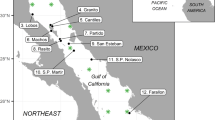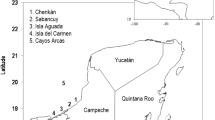Abstract
Environmental variation reflected by the North Atlantic Oscillation affects breeding and survival in terrestrial vertebrates1,2, and climate change is predicted to have an impact on population dynamics by influencing food quality or availability3. The North Atlantic Oscillation also affects the abundance of marine fish and zooplankton4,5, but it is unclear whether this filters up trophic levels to long-lived marine top predators. Here we show by analysis of data from a 50-year study of the fulmar that two different indices of ocean climate variation may have lagged effects on population dynamics in this procellariiform seabird. Annual variability in breeding performance is influenced by the North Atlantic Oscillation, whereas cohort differences in recruitment are related to temperature changes in the summer growing season in the year of birth. Because fulmars exhibit delayed reproduction, there is a 5-year lag in the population's response to these effects of environmental change. These data show how interactions between different climatic factors result in complex dynamics, and that the effects of climate change may take many years to become apparent in long-lived marine top predators.
This is a preview of subscription content, access via your institution
Access options
Subscribe to this journal
Receive 51 print issues and online access
$199.00 per year
only $3.90 per issue
Buy this article
- Purchase on Springer Link
- Instant access to full article PDF
Prices may be subject to local taxes which are calculated during checkout




Similar content being viewed by others
References
Post, E., Peterson, R. O., Stenseth, N. C. & McLaren, B. E. Ecosystem consequences of wolf behavioural response to climate. Nature 401, 905–907 (1999).
Milner, J. M., Elston, D. A. & Albon, S. D. Estimating the contributions of population density and climatic fluctuations to interannual variation in survival of Soay sheep. J. Anim. Ecol. 68, 1235–1247 (1999).
Sæter, B.-E. et al. Population dynamical consequences of climate change for a small temperate songbird. Science 287, 854–856 (2000).
Planque, B. & Taylor, A. H. Long-term changes in zooplankton and the climate of the North Atlantic. ICES J. Mar. Sci. 55, 644–654 (1998).
O'Brien, C. M., Fox, C. J., Planque, B. & Casey, J. Climate variability and North Sea cod. Nature 404, 142 (2000).
Lloyd, C., Tasker, M. L. & Partridge, K. The Status of Seabirds in Britain and Ireland (T & A. D. Poyser, London, 1991).
Fisher, J. The Fulmar (Collins, London, 1952).
Salomonsen, F. The geographical variation of the fulmar (Fulmaris glacialis) and the zones of marine environment in the North Atlantic. Auk 82, 327–355 (1965).
Brown, R. G. B. Fulmar distribution: a Canadian perspective. Ibis 112, 44–51 (1970).
Wynne-Edwards, V. Animal Dispersion in Relation to Social Behaviour (Oliver & Boyd, Edinburgh, 1962).
Kitaysky, A. S. & Golubova, E. G. Climate change causes contrasting trends in reproductive performance of planktivorous and piscivorous alcids. J. Anim. Ecol. 69, 248–262 (2000).
Post, E. & Stenseth, N. Climatic variability, plant phenology, and northern ungulates. Ecology 80, 1322–1339 (1999).
Gaillard, J.-M., Festa-Bianchet, M. & Yoccoz, N. G. Population dynamics of large herbivores: variable recruitment with constant adult survival. Trends Ecol. Evol. 13, 58–63 (1998).
Ollason, J. C. & Dunnet, G. M. in Reproductive Studies of Individual Breeding Systems (ed. Clutton-Brock, T. C.) 263–278 (Univ. Chicago Press, Chicago, 1988).
Dunnet, G. M. Population studies of the Fulmar on Eynhallow, Orkney Islands. Ibis 133, 24–27 (1991).
Mougin, J. L., Jouanin, C. & Roux, F. Intermittent breeding in Cory's Shearwater Calonectris diomedea of Selvagem Grande, North Atlantic. Ibis 139, 40–44 (1997).
Bradley, J. S., Wooller, R. D. & Skira, I. J. Intermittent breeding in the short-tailed shearwater Puffinus tenuirostris. J. Anim. Ecol. 69, 639–650 (2000).
Furness, R. W. & Bryant, D. M. Effect of wind on field metabolic rates of breeding Northern Fulmars. Ecology 77, 1181–1188 (1996).
Wilby, R. L., O'Hare, G. & Barnsley, N. The North Atlantic Oscillation and British Isles climate variability, 1965–1996. Weather 52, 266–276 (1997).
Phillips, R. A. et al. Diet of the northern fulmar Fulmar glacialis; reliance on commercial fisheries? Mar. Biol. 135, 159–170 (1999).
Briffa, K. R., Jones, P. D., Schweingruber, F. H. & Osborn, T. J. Influence of volcanic eruptions on Northern Hemisphere summer temperature over the past 600 years. Nature 393, 450–455 (1998).
Cooper, C. F. & Stewart, B. S. Demography of Northern elephant seals, 1911–1982. Science 219, 969–971 (1983).
Pomeroy, P. P., Twiss, S. D. & Duck, C. D. Expansion of a grey seal (Halichoerus grypus) breeding colony: changes in pupping site use at the Isle of May, Scotland. J. Zool. 250, 1–12 (2000).
Dunnet, G. M., Ollason, J. C. & Anderson, A. A 28-year study of breeding Fulmars Fulmaris glacialis in Orkney. Ibis 121, 293–300 (1979).
Dunnet, G. M. & Anderson, A. A method of sexing living Fulmars in the hand. Bird Study 8, 119–126 (1961).
Hurrell, J. W. Decadal trends in the North Atlantic Oscillation: regional temperatures and precipitation. Science 269, 676–679 (1995).
Ollason, J. C. & Dunnet, G. M. Nest failures in the Fulmar: the effect of observers. J. Field Ornithol. 51, 39–54 (1980).
Acknowledgements
We are indebted to the late G. Dunnet, who developed and directed the long-term field study on which these findings are based. Thanks also to A. Anderson, P. Heppleston, P. Doyle, P. Cosgrove and many other colleagues who assisted with data collection and analyses; and to S. D. Albon, P. F. Billingsley, J. W. Durban, D. A. Elston, M. L. Gorman, X. Lambin, J. G. Ollason and W. R. Turrell for advice and discussion. Orkney Islands Council and the late J. M. Robertson kindly provided access to facilities on Eynhallow.
Author information
Authors and Affiliations
Corresponding author
Rights and permissions
About this article
Cite this article
Thompson, P., Ollason, J. Lagged effects of ocean climate change on fulmar population dynamics. Nature 413, 417–420 (2001). https://doi.org/10.1038/35096558
Received:
Accepted:
Issue Date:
DOI: https://doi.org/10.1038/35096558
This article is cited by
-
Citizen science data reveal possible multi-decadal phenological changes in the arrival time of a migratory tropical seabird species at the breeding ground
Marine Biology (2023)
-
Behavioural flexibility in an Arctic seabird using two distinct marine habitats to survive the energetic constraints of winter
Movement Ecology (2022)
-
The Major Roles of Climate Warming and Ecological Competition in the Small-scale Coastal Fishery in French Guiana
Environmental Modeling & Assessment (2021)
-
Host-microbiota interaction helps to explain the bottom-up effects of climate change on a small rodent species
The ISME Journal (2020)
-
Direct and indirect effects of temperature and prey abundance on bald eagle reproductive dynamics
Oecologia (2020)
Comments
By submitting a comment you agree to abide by our Terms and Community Guidelines. If you find something abusive or that does not comply with our terms or guidelines please flag it as inappropriate.



